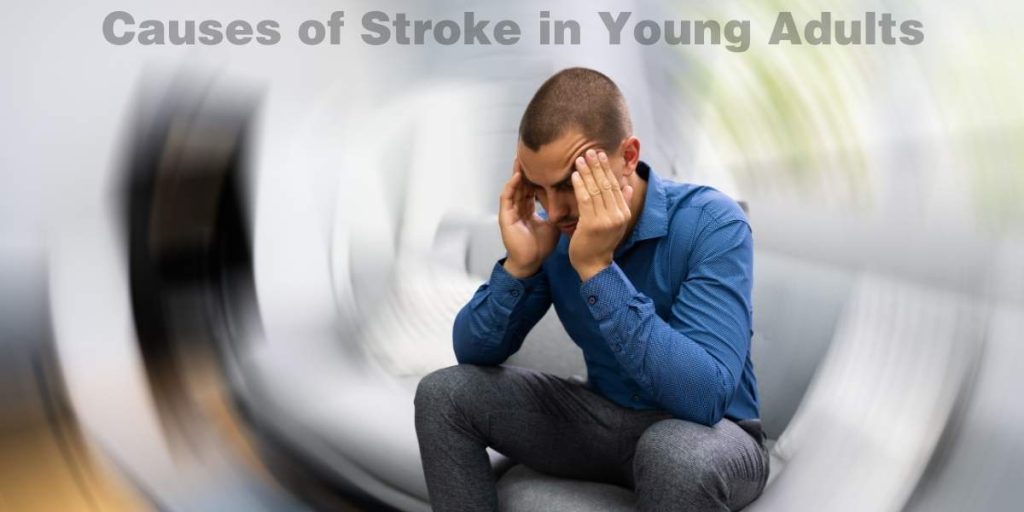Stroke is often seen as a condition affecting the elderly, but the reality paints a different picture.Causes of Stroke in Young Adults. In recent years, the prevalence of strokes among young adults has risen alarmingly, making it crucial to understand its causes. This article explores the multifaceted reasons behind strokes in individuals aged 18 to 45, shedding light on preventable factors and actionable steps to mitigate risks.
What is a Stroke?
Definition and Explanation Causes of Stroke in Young Adults
A stroke arrives when blood Stream to the brain is interrupted, either due to a blockage or a slit blood vessel. This disruption deprives the brain of oxygen and nutrients, leading to cell damage or death.

Types of Stroke
- Ischemic Stroke: Caused by blood clots or other obstructions in the arteries.
- Hemorrhagic Stroke: Resulting from bleeding within or around the brain.
- Transient Ischemic Attack (TIA): Often called a “mini-stroke,” it temporarily blocks blood flow without permanent damage.
Prevalence in Young Adults
Rising Stroke Incidences in Ages 18–45
Recent studies highlight an unsettling increase in stroke cases among younger populations. Factors such as lifestyle changes, stress, and undiagnosed medical conditions contribute to this surge.
Key Statistics Highlighting Trends Causes of Stroke in Young Adults
- Stroke rates among young adults have risen by 40% over the past two decades.
- Approximately 10–15% of all strokes now occur in individuals under 45.
Understanding Stroke Causes
Broad Categories of Stroke Causes
The causes of stroke can be divided into: Causes of Stroke in Young Adults
- Lifestyle-related factors.
- Medical and genetic predispositions.
- Environmental and neurological influences.
Differences Between Young and Elderly Stroke Causes
Unlike strokes in the elderly, often tied to age-related conditions, strokes in young adults frequently involve modifiable lifestyle choices and less obvious medical issues.
Lifestyle Factors
Smoking and Tobacco Use
Smoking accelerates atherosclerosis, narrowing blood vessels and increasing clot risks.
Sedentary Lifestyle and Obesity
Physical inactivity contributes to obesity, hypertension, and diabetes, all major stroke risk factors.
Alcohol and Substance Abuse
Excessive alcohol and recreational drug use can lead to irregular heart rhythms, increasing stroke likelihood.
Medical Conditions: Causes of Stroke in Young Adults
Hypertension and Its Role in Stroke
High blood pressure strains blood vessels, increasing the risk of rupture or blockage.
Diabetes and Cardiovascular Risk
Uncontrolled blood sugar damages blood vessels, raising stroke susceptibility.
Autoimmune Disorders Impact
Conditions like lupus or antiphospholipid syndrome can increase clot formation and inflammation in blood vessels.
Genetic and Hereditary Risks
Family History of Stroke :Causes of Stroke in Young Adults
A family history of stroke or cardiovascular disease significantly raises individual risk.
Inherited Clotting Disorders
Genetic conditions like Factor V Leiden mutation make individuals more prone to clotting.
Neurological Causes: Causes of Stroke in Young Adults
Arteriovenous Malformations (AVMs)
AVMs are abnormal tangles of blood vessels that can rupture, causing hemorrhagic strokes.
Cerebral Aneurysms
Weak spots in blood vessel walls can balloon and burst, leading to severe strokes.
Rare and Unusual Factors: Causes of Stroke in Young Adults
Hormonal Birth Control and Stroke Risks
Oral contraceptives, especially in smokers or women with migraines, slightly increase stroke risks.
Migraine with Aura: Causes of Stroke in Young Adults
Research shows a link between migraines with aura and ischemic strokes in young adults.
Drug-Induced Strokes: Causes of Stroke in Young Adults
Stimulant drugs like cocaine and amphetamines can cause vasospasms, leading to strokes.
Role of Stress and Mental Health
Chronic Stress and Its Physical Impacts
Prolonged stress elevates cortisol levels, contributing to hypertension and cardiovascular strain.
Depression and Stroke Correlation
Mental health conditions like depression are increasingly recognized as stroke risk factors.

Environmental Contributors
Pollution and Stroke Risk
Exposure to high levels of air pollution has been linked to increased stroke incidences.
Impact of Work and Sleep Patterns
Irregular work hours and poor sleep hygiene can disrupt heart rhythms and blood pressure.
Diagnostic Challenges: Causes of Stroke in Young Adults
Recognizing Symptoms in Young Adults
Symptoms like numbness, weakness, or slurred speech may be overlooked in younger individuals.
Misdiagnosis and Its Consequences
Stroke symptoms can mimic other conditions, delaying crucial treatment.
Preventative Measures
Healthy Lifestyle Choices: Causes of Stroke in Young Adults
- Regular exercise and a balanced diet can reduce stroke risks significantly.
- Overlook smoking and moderating- alcohol intake are necessary steps.
Routine Checkups and Awareness
Annual health screenings can detect underlying conditions early.
Early Interventions and Treatment
Timely medical care during a TIA or mild stroke can prevent major complications.
The Role of Education
Raising Awareness Among Young Adults
Educational campaigns can highlight stroke symptoms and prevention strategies.
Importance of Community and Policy Initiatives
Governments and organizations should support stroke awareness and funding for research.
FAQs on Stroke in Young Adults: Causes of Stroke in Young Adults
1. What are the warning signs of a stroke?
General signs comprise sudden inertness, confusion, disadvantage speaking, and loss of balance.
2. Can stress alone cause a stroke?
While not directly causing strokes, chronic stress contributes to conditions that increase stroke risk.
3. Is stroke recovery different for young adults?
Yes, younger individuals often recover better due to higher neuroplasticity but still face challenges.
4. How is stroke diagnosed?
Imaging tests like CT or MRI scans and blood tests are essential for accurate diagnosis.
5. Can lifestyle changes prevent strokes?
Absolutely. Diet, exercise, and regular checkups are effective preventive measures.
6. Are strokes hereditary?
Genetic factors can play a role, but lifestyle and medical conditions also significantly impact risk.
Conclusion
Understanding the causes of stroke in young adults is critical for prevention and timely intervention. By addressing lifestyle factors, managing medical conditions, and promoting awareness, we can curb the rising trend of strokes in this age group.